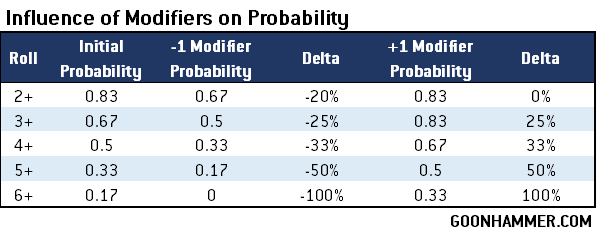This week’s Hammer of Math looks at the new Bondsman abilities released in the new Codex: Imperial Knights book.
I’ve always been a fan of the idea of Imperial Knights. Giant chivalric war machines crushing the enemy with man-sized power fists and thermal lances just sounds really cool, and the fact that a 2000 point army can be made with just a few models really appeals to my backlog. When the last Codex: Imperial Knight book dropped I went all-in with a Knight Preceptor and a host of Armiger Warglaives and Helverins. The only problem was that I wanted to bring this army to the NOVA Open and Canis Rex wasn’t available yet, so I modeled and printed my own las-impulsor. I had my share of fun using the Helm Dominatus to point at a particular threat and overwhelm it with firepower, but over time it became apparent that Armigers weren’t particularly survivable for their points and the Preceptor wasn’t particularly lethal on its own. So by the time 9th dropped they were mostly commanding my display case. But I’m still proud of these oversized monstrosities and my backlog has at least three other Knights I could build, so with the release of the new book I’m excited to see how things have changed.
The biggest alteration to Imperial Knights under the new book are enhancements applied by the Questoris-class units to the Armiger-class models. The three means by which this occurs are from Bondsman abilities, the Exalted Court bonuses, and Knightly Teachings. Many of these bonuses synergize and can produce cumulative effects which make the Armigers faster, more lethal, or significantly harder to kill.
Bondsman Abilities
One of the core features of the new Codex: Imperial Knights is the use of Bondsman abilities to have the larger Questoris-class knights give various boosts to nearby Armiger units. In general, Knight Errants, Wardens, Crusaders, Gallants, and Paladins have the ability to boost one Armiger-class unit with 12″. This number can be increased through different effects such as making a knight a member of the Exalted Court (enabling one additional use of the Bondsman ability), the High Monarch Noble Exemplar ability (which adds a 6″ aura to the the Bondsman ability), or The Wisdom of Nobility Knightly Teacher (which allows a Bondsman ability to apply to two Armigers within 6″ of each other). In this section we examine the numerical impacts of each Knight’s Bondsman ability.
The Knight Errant has Errant’s Duty, which has the dual benefits of enabling a unit to charge in the turn that it advanced and adding 1 to any Advance and Charge roll made for that unit. Obviously preferable on a Warglaive, this allows an unwounded unit to have an with a total charge range of 14 + 3d6 inches. This effectively guarantees that the Armiger will be able to charge anything within 18″, and will be able to charge something 25″ away the majority of the time.
The Knight Warden provides the Warden’s Duty ability which allows the target Armiger class model to count as 10 models for the purpose of controlling objective markers. The math here is pretty simple; Armigers already come with Objective Secured and count as 5 models so this doubles that ability.
The Knight Crusader granted Crusader’s Duty which improves the Ballistic Skill of a target Armiger by 1. The Knight Gallant has a similar bonus with Gallant’s Duty which enhances the Weapon Skill of the Armiger by 1. The Warglaive and Helverin have a 3+ for both their undamaged WS and BS, which means that the Bondsman abilities will each provide a 25% increase to output. Since the bonus affects the BS or WS itself the effect is not subject to the +1/-1 modifier limit on hit rolls.
The Knight Paladin grants the Paladin’s Duty bonus, which allows both hit and wound rolls of 1 to be re-rolled. Re-rolls provide a fixed improvement to probability based on the value being re-rolled. In the case of re-rolling results of 1 the improvement is 17% (1/6) per test. Where things get interesting is that the effect is multiplicative when multiple rolls gain the bonus. The cumulative effect of re-rolling 1s to hit and wound is a 36% improvement, which makes the Paladin ability superior to the WS and BS bonuses of the Crusader and Gallant. The Paladin ability also has the bonus of being applicable to both ranged and melee combat.
Exalted Court
The Exalted Court is a series of points-based upgrades that can be applied to various Knight characters. Divided between options for Questor Imperialis and Questor Mechanicus, every Exalted Court bonus provides the option for an additional application of a Bondsman ability as well as a Noble Exemplar Ability which is generally an boost that’s provided to a unit that’s under the model’s respective Bondsman ability. There are a few Noble Exemplar Ability powers which have a significant numerical effect and I can discuss the impact below.
Gatekeeper increases the Toughness characteristic of Armiger class units from 7 to 8 while under the effect of a Bondsman ability, which is significant given the number of S7 and S8 weapons designed to kill light vehicles. The chart below shows the delta for a negative reduction in probability, where against S7 or S8 threats the reduction in probability is 50% and 33% respectively.
Herald is an immensely powerful ability which increases the invulnerable save of an Armiger from a 5+ to a 4+. One way to look at the effect is from the perspective of how many attacks are required to defeat a save. Any attack that is saved forces a subsequent attack on the same target, which can also potentially be saved (and so forth). The formula is (1 / [1 – P(Save)]) and for a 5+ save the value is 1.5 while for a 4+ the value is 2. If you multiply this value by the Wounds characteristic of the target you get the effective wounds. For example a 12 wound Armiger has an effective wounds characteristic of 18 with a 5+ and a 24 with a 4+. In other words going from a 5+ invulnerable to a 4+ is the equivalent of giving the Armiger 6 more wounds.
Forge Master is an extremely niche effect. It provides a +1 to both the hit and wound roll for the attack of an Armiger under its Bondsman ability when the target is within the deployment zone. For the hit roll going from a 3+ to a 2+ provides a 25% increase, and much like the Paladin’s Duty bonus this is multiplied by the bonus for the wound roll. For an attack of a BS 3+ hit against a target that’s wounded on a 3+ (such as a Warglaive firing its thermal spear) the effect of the Forge Master bonus is a 56% improvement. Should the Forge Master happen to be a Knight Paladin then the bonus is now 113%. Unfortunately the deployment zone limitation on the target makes this challenging to utilize, but the 30 point ability also provides 1 point of Damage reduction so long as the Knight remains wholly within the deployment zone.

Knightly Teachings
Knightly Teachings are functionally identical to Chaplain prayers. During the Command phase the player chooses a Knightly teaching and rolls a D6 to see if the teaching is inspiring (either a 3+ or a 2+ for a Knight Preceptor with the Mentor’s Seal). If the teaching is inspiring then a bonus is applied to either a single Armiger model or all Armigers within 6″ of the model. The units that can utilize this ability are either Knight Preceptor (which can recount two teachings per Command phase) or Questor Mechanicus models with the Master of Lore Exalted Court upgrade (one teaching per Command phase). Both the Preceptor and the Master of Lore gain the MENTOR keyword and can use the Recount the Virtues stratagem for 1 CP, which allows the unit to automatically recount any teaching that has not already been recounted by a friendly model that turn. There are two Knightly Teachings which have a numerical impact.
The Virtue of Courage is an aura which allows Armiger units within 6″ of the mentor to get an extra hit on unmodified hit rolls of 6. In terms of impacting probability this is identical to giving the model a +1 to hit (since a result of 6 is now 2 hits), with the added bonus that it also boosts units which have a 2+ to hit. For example, a 3+ to hit averages 0.66 hits per attack (2/3). Making it a 2+ to hit changes the average to 0.83 (5/6). This is identical to the effect of adding a second hit every time there’s a six on the dice (2/3 + 1/6 = 0.83).
The Knight’s Faith is an aura which gives Armiger units within 6″ the ability to ignore wounds on a 6+, or if the unit is under the effect of a Bondsman ability then the roll is a 5+. The effect of ignoring wounds is identical to that of improving a save, only the results can be even more dramatic since there was no save to begin with. Ignoring wounds on a 6+ is an effective 20% increase in the number of wounds the target has, while going to a 5+ is an effective 50% increase. What’s even more impressive is that the effect is multiplicative when combined with improving a save. This means that an Armiger under the bonus of The Knight’s Faith and the Herald’s 4+ invulnerable save goes from an effective 18 wounds to a whopping 36. Another way to look at it is that the combination of these effects makes an Armiger twice as hard to kill.

Wrapping Up
This is cool. While Imperial Knights require a bit of coordination and care to set up, when properly executed the results can be very impressive. Previously, Armigers were largely an underpowered joke – the new rules make things much more dynamic and interesting for players. I’m excited to see where things go and what combinations players find most useful as they stomp over the battlefield.
Thanks for reading! If you have any questions or comments feel free to drop us a note in the Comments below or email us at contact@goonhammer.com. That’s also the best way to suggest topics for future articles.






